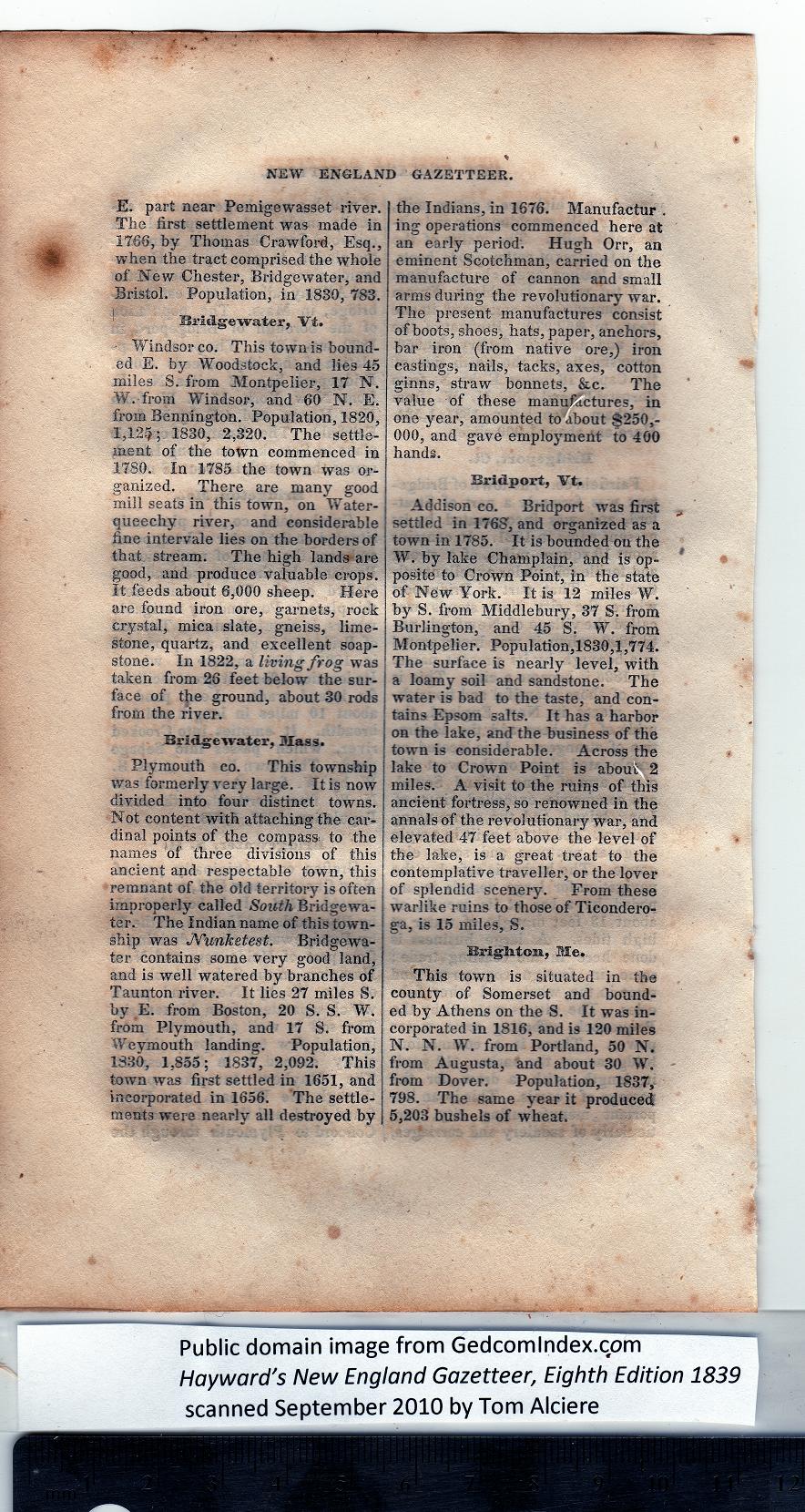|
E. part near Pemigewasset river.
The first settlement was made in
1766, by Thomas Crawford, Esq.,
when the tract comprised the whole
of New Chester, Bridgewater, and
Bristol. Population, in 1830, 783.
Bridgewater, Vt.
Windsor co. This town is bound-
ed E. by Woodstock, and lies 45
miles S. from Montpelier, 17 N.
W. from Windsor, and 60 N. E.
from Bennington. Population, 1820,
1,12$; 1830, 2,320. The settle-
ment of the town commenced in
1780. In 1785 the town was or-
ganized. There are many good
mill seats in this town, on Water-
queechy river, and considerable
fine intervale lies on the borders of
that stream. The high lands are
good, and produce valuable crops.
It feeds about 6,000 sheep. Here
are found iron ore, garnets, rock
crystal, mica slate, gneiss, lime-
stone, quartz, and excellent soap-
stone. In 1822, a living frog was
taken from 26 feet below the sur-
face of the ground, about 30 rods
from the river.
Bridgewater, Mass.
Plymouth co. This township
was formerly very large. It is now
divided into four distinct towns.
Not content with attaching the car-
dinal points of the compass^ to the
names of three divisions of this
ancient and respectable town, this
remnant of the old territory is often
improperly called South Bridgewa- j
ter. The Indian name of this town- j
ship was JYunketest. Bridgewa-
ter contains some very good land,
and is well watered by branches of
Taunton river. It lies 27 miles S.
hy E. from Boston, 20 S. S. W.
from Plymouth, and 17 S. from
Weymouth landing. Population,
1830, 1,855; 1837, 2,092. This
town was first settled in 1651, and
incorporated in 1656. The settle-
ments were nearly all destroyed by
the Indians, in 1676. Manufaetur .
ing operations commenced here at
an early period. Hugh Orr, an
eminent Scotchman, carried on the
manufacture of cannon and small
arms during the revolutionary war.
The present manufactures consist
of boots, shoes, hats, paper, anchors,
bar iron (from native ore,) iron
castings, nails, tacks, axes, cotton
ginns, straw bonnets, &c. The
value of these manulStctures, in
one year, amounted to About $250,-
000, and gave employment to 400
hands. |
Bridport, Vt.
Addison co. Bridport was first
settled in 1768, and organized as a
town in 1785. It is bounded on the
W. by lake Champlain, and is op-
posite to Crown Point, in the state
of New York. It is 12 miles W.
by S. from Middlebury, 37 S. from
Burlington, and 45 S. W. from
Montpelier. Population,1830,1,774.
The surface is nearly level, with
a loamy soil and sandstone. The
water is bad to the taste, and con-
tains Epsom salts. It has a harbor
on the lake, and the business of the
town is considerable. Across the
lake to Crown Point is about 2
miles. A visit to the ruins of this
ancient fortress, so renowned in the
annals of the revolutionary war, and
elevated 47 feet above the level of
the lake, is a great treat to the
contemplative traveller, or the lover
of splendid scenery. From these
warlike ruins to those of Ticondero-
ga, is 15 miles, S.
Brighton, Me.
This town is situated in the
county of Somerset and bound-
ed by Athens on the S. It was in-
corporated in 1816, and is 120 miles
N. N. W. from Portland, 50 N.
from Augusta, and about 30 W.
from Dover. Population, 1837,
798. The same year it produced
5,203 bushels of wheat. |
